Labview is a graphical programming language developed by NI (National Instruments). It is GUI based language which uses icons instead of text. It is used in wide variety of applications such as acquiring Data, processing of acquired data, control of instruments, automation, RF and wireless test and measurement, monitoring and control, application development etc. The applications developed using labview can be offline or online. Offline applications are just PC based and do not have any realtime interface with equipments. Online applications are designed to work along with instruments and hence required drives to interface with instrument’s memory and DAC/ADC modules.

Job Oriented Labview Training Bangalore
This page provides contents delivered in online labview training offered by Innowitech, Bangalore. Sophisticated Skype and team viewer is used for the same. This job oriented labview training is very useful to secure job easily.
Labview online training is offered by our highly experienced labview trainers who have experience of more than 15 years in the Test and Measurement domain encompassing both RF and Wireless technologies. Our trainers have worked in RF, PHYSICAL LAYER based on WLAN, WIMAX, ZIGBEE etc. This labview online training is ideal for beginners as well as job seekers in the labview domain.
Online Labview Training Course Contents
- Introduction
- Dataflow Programming
- Graphical Programming
- Benefits
- Start using LabView
- The Labview Environment
- Front Panel
- Block Diagram
- Controls Palette
- Numeric Sub Palette
- Boolean Sub Palette
- String & Path Sub Palette
- Function Palette
- Tools Palette
- Wiring
- Toolbar
- Execution
- The Objects shortcut menu
- Dataflow Programming
- Help
- Exercises
- Sub VIs
- Create New Sub VI from Scratch
- Input and Output Sub VI Connectors
- Icon Editor
- Create Sub VI from existing code
- Using Sub VIs
- Create New Sub VI from Scratch
- Customize Labview
- Loops and Structures
- Loops
- for Loop
- While Loop
- Structures
- Case Structure
- Sequence Structure
- Event Structure
- Loops
- Troubleshooting and Debugging
- How to find errors
- Highlight Execution
- Probes
- Breakpoints
- Step into/over/out debugging
- Working with Data
- Arrays
- Cluster
- Working with Strings
- Error Handling
- Finding Error
- Error Wiring
- Error Handling in Sub VIs
- Error Handling
- Working with Projects
- Project Explorer
- Deployment
- Design Techniques
- Force Program Flow
- Shift Register
- State Programming Architecture
- Multiple Loops/Parallel programming
- Templates
- User Interface
- VI Properties
- Plotting Data